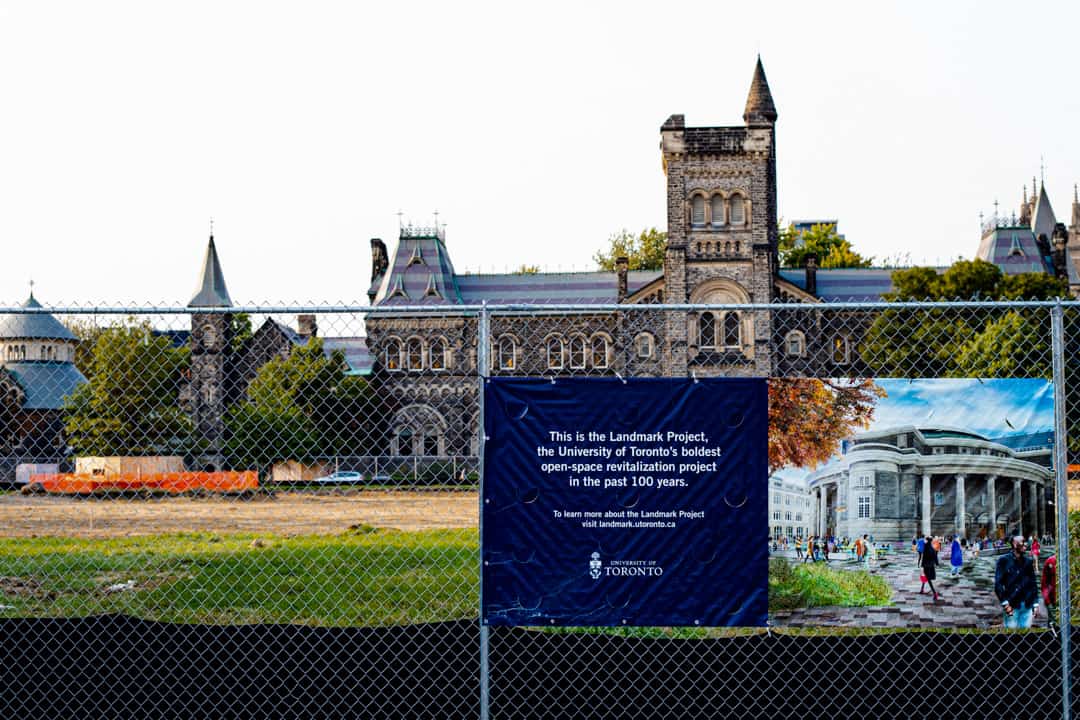As most students have been absent from the UTSG campus since March due to the ongoing pandemic, many might have missed the fence that was raised around front campus this summer.
This fence, accompanied by the heavy machinery digging holes in the ground, is only the beginning of a massive project that the university has been calling the Landmark Project. The initiative promises to transform not only front campus, but also back campus, the Sir Daniel Wilson Quad, Hart House Circle, and King’s College Circle.
New additions
Top-billed among the Landmark Project changes is the construction of what will be Canada’s largest urban geothermal field below front campus, which is expected to generate renewable energy and thus prevent the emission of 15,000 tonnes of greenhouse gases every year.
According to U of T News, the amount of greenhouse gases saved will be equivalent to removing 3,000 cars off the roads — an important endeavour in making the university a greener institution in the midst of the ongoing climate crisis.
This initiative is also set to make the UTSG campus more accessible, as the university promises to replace a number of stairs and ramps with gradual slopes.
While this all definitely sounds impressive — and to a large extent, truly is — some of the aspects of the project demand to be questioned.
Less space to operate
One question to ask would be whether it is truly necessary, and frankly appropriate, to begin this construction amidst the COVID-19 pandemic.
The university has claimed that in this initial phase of the project, it will be easy for physical distancing to be observed, as only a small number of people are on the site at a time. However, in the midst of COVID-19 cases once again rapidly increasing in Toronto, U of T should not be putting construction workers at risk on a non-essential project such as this.
In the same vein, every bit of outside space should be conserved to aid in physical distancing efforts. With the front campus field cut off, people are forced to stay on the narrow walkways, and in some situations, be too close for comfort — even with the current reduced number of students on campus.
Question of financial transparency
The cost of the Landmark Project also needs to be addressed. U of T News reported that this project will take three years to complete, and while an official price tag has not been made public, it is known that U of T received a $100,000 grant from the Toronto Parks and Trees Foundation, a $250,000 gift from the University of Toronto Students’ Union, and $1 million from the University of Toronto Alumni Association.
The university set out its funding sources for the Landmark Project during an in-camera session of the Planning & Budget Committee — meaning that the press and general public were not informed about the results of the meeting. While the university is funding the renovation in part through the Future Major Capital Project Reserves, the dollar amount that U of T is putting toward this project remains unknown.
During a pandemic that has financially impacted a large number of U of T students and staff, this lack of transparency related to expenditures calls U of T’s commitment to the betterment of the community into question.
As The Varsity reported in July, the university has temporarily laid off nearly 200 employees during the pandemic. In addition, even as almost all classes have moved to an online setting, the price of tuition has been kept the same for domestic students and increased for international students.
For students, this is especially pressing considering that many have faced financial hardship due to the pandemic and will also not be able to enjoy the benefits of campus such as libraries, gyms, and study spaces.
While the Landmark Project is undoubtedly a very impressive initiative by the University of Toronto, it is by no means problem-free.
Yes, it will make the downtown campus more accessible and greener — both figuratively and literally. Nonetheless, the timing for the start of the construction amidst the COVID-19 pandemic is poor and raises many questions about the safety of having active construction right in the heart of UTSG and the appropriate use of university funds.
Guilherme Patury is a third-year international relations student at University College.


